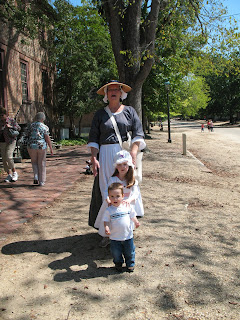Mary, Mary quite contrary.
How does your garden grow?
With silver bells and cockle shells,
And pretty maids all in a row.
Then we headed out to a field and talked about how they used candles to light their way. Then the kids got to jump over a candle stick as they were saying the rhyme. Olivia thought this was great fun. Gabe wanted to try it but didn't quite get it.
Jack be nimble,
Jack be quick,
Jack jump over the candlestick!
Next we went to visit the town Cooper. He makes barrels and pails. The kids each got to pick up the pails full of water and see how heavy it might have been.
Jack and Jill went up the hill
To fetch a pail of water;
Jack fell down and broke his crown
And Jill came tumbling after.
Then we headed into a shady garden area. This was a common place for children to play during colonial days. They played a game called Thread the Needle. Gabe was eager to join in the fun here, too. The garden was surrounded by a brick wall which led to another nursery rhyme.
Humpty Dumpty sat on a wall
Humpty Dumpty had a great fall
All the king's horses and all the king's men
Couldn't put Humpty together again
The kids were each given a bag with the nursery rhymes, a shell, a burnt candle stick, a wood shaving, and a small brick. Note: These nursery rhymes actually all have conflicting orgins and meanings if you look them up on Wikipedia or other such resource. Here is an interesting resource about kid's books and colonial times: http://www.history.org/history/teaching/enewsletter/volume2/june04/pocketbook.cfm






